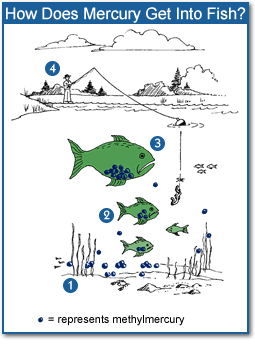Bioaccumulation of Mercury
 Once in a lake or river, mercury is converted to methylmercury
by bacteria and other processes. Fish absorb methylmercury from their food and from water as it passes over their gills. Mercury is tightly
bound to proteins in all fish tissue, including muscle. There is no method of cooking or cleaning fish that will reduce the amount of mercury
in a meal. Once in a lake or river, mercury is converted to methylmercury
by bacteria and other processes. Fish absorb methylmercury from their food and from water as it passes over their gills. Mercury is tightly
bound to proteins in all fish tissue, including muscle. There is no method of cooking or cleaning fish that will reduce the amount of mercury
in a meal.
Methylmercury accumulates as you move up the food chain:
- Methylmercury in the water and sediment is taken up by tiny animals and plants known as plankton.
- Small fishes eat large quantities of plankton over time.
- Large predatory fish consume many smaller fish, accumulating methylmercury in their tissues. The older and larger the fish, the greater
the potential for high mercury levels in their bodies.
- Fish are caught and eaten by humans and animals, causing methylmercury to accumulate in their tissues.
The State of Vermont Fish Contaminant Monitoring Program has been monitoring the levels of mercury in fish tissue since 1987. Measureable
concentrations have been observed in 95% of the samples collected from lakes and rivers across the state. The Vermont
Department of Health has issued a fish
consumption advisory has issued a fish
consumption advisory which recommends consumption levels based on fish species and
special advisories for certain water bodies. The advisory is also more protective of women of childbearing age and children under age 6. which recommends consumption levels based on fish species and
special advisories for certain water bodies. The advisory is also more protective of women of childbearing age and children under age 6.
|


 Once in a lake or river, mercury is converted to methylmercury
by bacteria and other processes. Fish absorb methylmercury from their food and from water as it passes over their gills. Mercury is tightly
bound to proteins in all fish tissue, including muscle. There is no method of cooking or cleaning fish that will reduce the amount of mercury
in a meal.
Once in a lake or river, mercury is converted to methylmercury
by bacteria and other processes. Fish absorb methylmercury from their food and from water as it passes over their gills. Mercury is tightly
bound to proteins in all fish tissue, including muscle. There is no method of cooking or cleaning fish that will reduce the amount of mercury
in a meal.